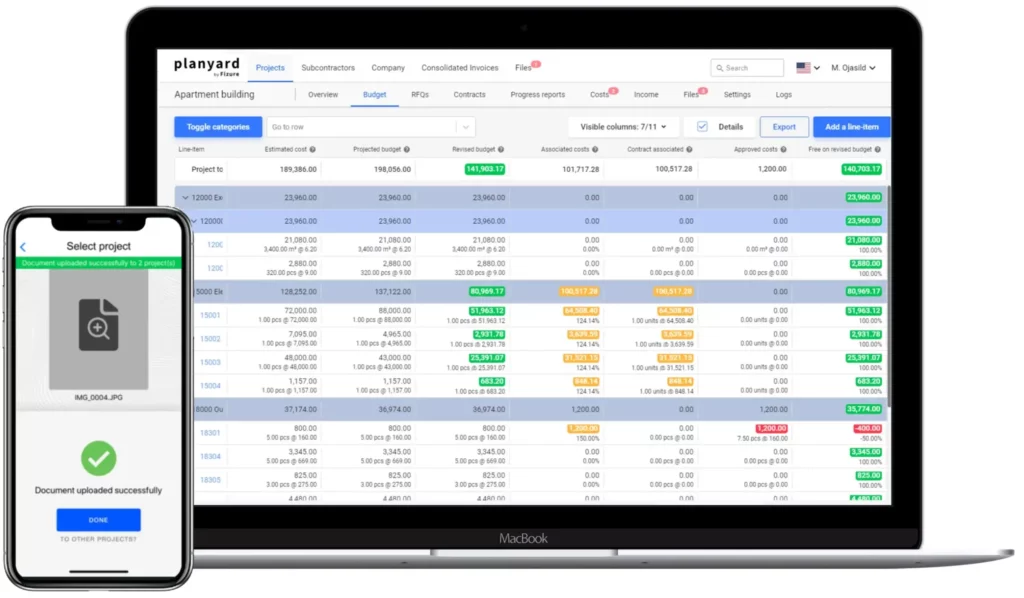



What does Brown & Bancroft do?
We are a fit-out main contractor. We fit out all sorts of spaces ranging from colleges, and reception spaces in office buildings, to offices themselves. In addition to that, we also fit out warehouses, schools, health centers, and much more.
We do everything from building new walls, doing external works, painting and decorating, new floor finishes, meeting rooms, breakout spaces, and other similar solutions. So really, whatever our various customers are looking for. We also do the design with our in-house design team. Our Clients hand over their space and our Designers create a concept according to their brief, we then follow on and bring that concept to reality.
What is your role and what do you do?
I am an estimator and quantity surveyor at Brown & Bancroft. I work across the full pre-contract and construction phases of the project. Sometimes I do undertake the full take-off & tender and see the project through to completion, and sometimes I undertake the QS role once the scheme has been handed over from our Pre-Construction team.

What kind of tools have you used in the past?
At Brown & Bancroft we’ve just been using Excel and e-mails until now to do all of our project management. While they are good for the task they have been designed for, you are still open to human error. They do serve a purpose, but for this task, it is not ideal. You might forget to add or adjust something or make some other hidden mistake somewhere.
I have used software packages at other companies in the past. One of them is Navision from Microsoft and there are also some UK-based packages that I remember. Navision is of course more of a generic ERP tool that is definitely not without its own flaws.
How would you describe Planyard in your own words?
Planyard is a live overview of your project. How they are performing financially and it is basically a CVR that is live all the time. It has up-to-date data. You can see how your jobs are performing, where you’re making profits, and where you aren’t making profits.
Because it is online, it gives me the opportunity to use it on the site. I could be on-site with a subcontractor and we are discussing the change orders and I can just add them to the subcontract right as we are discussing them.
I can do that because I can log on straight into the system without special VPNs or something specific configured on my desktop computer. I can just get straight on and log it. It’s really easy to manage the costs of all jobs.
Planyard is a live overview of your project. How they are performing financially and it is basically a CVR that is live all the time.
Claire Hill, Brown & Bancroft
How did it work with getting subcontractors on board for monthly valuations?
The feedback from subcontractors was really good! We’ve sent out our valuation form link to a number of subcontractors already. Only some of them are hesitant to get on board because that’s not how they are used to working. A lot of the other subbies have just jumped straight onto it and clicked the link we sent them.
They’ve been able to upload their valuations themselves and have just called me saying “I’ve done it now. Can you see it already?”. It has only been just to make sure that I have received them. I can see it straight away and it’s easy for me to do what I need to do with the valuation. When I’ve reviewed it, they get feedback right away.
I’ve been really pleasantly surprised that the subbies have really gotten on board with it and they are quite happy to submit their valuations and invoices online. It’s a lot easier for us in the office because of this!
I’ve been really pleasantly surprised that the subbies have really gotten on board with it and they are quite happy to submit their valuations and invoices online. It’s a lot easier for us in the office because of this!
Claire Hill, Brown & Bancroft
What has changed since you started to use Planyard instead of spreadsheets?
I have saved a lot of time! It’s so much easier now that I am less reliant on Excel. When we’ve been awarded a project and we’ve uploaded the project on Planyard, I don’t need to look at spreadsheets anymore. I can just ignore Excel after that point and I can just go through that tool for all of the surveying work.
CVRs are so much easier to manage because the information is there and it’s live. It’s reduced mistakes as well because we have the information there at our fingertips and it never gets forgotten about. So it’s saved time and money, really.
How much time and effort have you saved?
It’s hard to say, but I have probably saved half a day to a day per week due to less manual reporting. Maybe we could even say that it is up to a week per month. When we used to do our month-end CVRs it could usually take 3-4 days to put them together.
It now takes me 10-15 minutes to just quickly go through the jobs and check that I haven’t missed anything. It’s just so much smoother and easier! It just visualizes everything for me and it definitely makes it easier for me.
I’m sure I could even be doing more with it. I know that I am not using the full extent of it yet, and I am already feeling the benefits. It’s been really helpful for us as a business. At any point, one of the Directors can walk up to me, and in two clicks I have all of the information in front of me.
I can probably […] even say that it is up to a week per month. When we used to do our month-end CVRs it could usually take 3-4 days to put them together.
Claire Hill, Brown & Bancroft
What are the weaknesses of Planyard?
I think some of the dashboards and graphs don’t mean anything to me. They for sure can be helpful for someone else, but not for me.
There is a monthly project profit percentage missing from the project overview page. All of the numbers and amounts are there, but I just have to calculate the profitability percentage manually still at the moment for some of our meetings. This is, of course, a small change that I already proposed to the team and they already said they’d take look at it.
One other this is the forecasting of spend for the next month or for the next few months. So that the financial team knows how much money we need to pay out our suppliers and subbies. If we could do it on Planyard, it would get rid of another spreadsheet to plan the cash flow of the company.
How complex was it to start with Planyard?
It’s not complex at all. It’s a really easy and user-friendly system to use. I was sent an email with my login credentials and I just signed it. I can see the information there straight away.
I only watched some tutorial videos on the Planyard website and I’ve been able to get straight on it. It’s really intuitive to use! For example, there’s a button that says “Subcontracts” and you can fill in the information. It leads you along the path of what to do. It doesn’t really need any thorough training to use.
I’ve used other systems in the past that you need 3 or 4 days of training before you can even raise a purchase order on the system. With Planyard, you can just raise your first purchase order in 5 minutes in one go. “You just Planyard it!”
I’ve used other systems in the past that you need 3 or 4 days of training. With Planyard, you can just raise your first purchase order in 5 minutes in one go.
Claire Hill, Brown & Bancroft
Who is this system useful for?
I think that the majority of SMEs would benefit from it, whether you are a small contractor who builds extensions on residential buildings or if you turn over 10-15 million pounds a year.
I log my mileage through the mobile app and it just goes straight to the correct place. When I come into the office I can just click on it, allocate it where it needs to go, and it’s done. I don’t need to fill out a monthly expense sheet. For little things like that, it’s really useful.
Video of the interview
Bruger du stadig Excel til budgetstyring?
Der er en bedre måde.


Regneark er ikke den bedste måde at styre jobomkostninger på
- Det er for let at lave fejl;
- Du kan ikke se bag tallene;
- Det er svært at standardisere og sikre overholdelse;
- Der er ingen realtidsoversigt over rentabilitetsprognoser;
- Det betyder dobbeltarbejde for PM’er og revisorer.
Planyard sparer tid og nerver
Følg dit budget i realtid, og gør øjeblikkelig handling, når der opstår fejl. Jobomkostninger er organiserede og fuldt søgbare og tilgængelige til prognoser, projektledelse og mere.